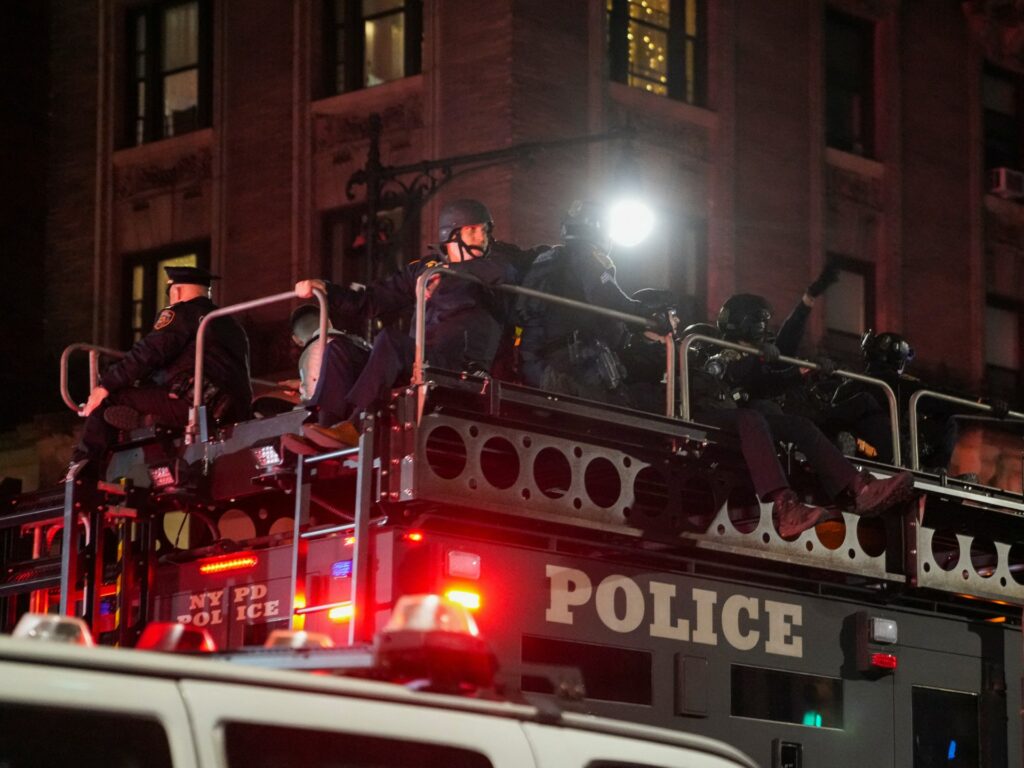New York City police officers entered Columbia University campus as the Gaza protest escalated on Tuesday night. The police, wearing riot gear, headed for Hamilton Hall, which students had been occupying since Tuesday morning, as well as the main campsite. This move came as part of the larger Gaza protests that have been taking place at universities across the United States.
The New York Police Department received authorization from Columbia to take action before entering the campus. Live television footage showed a large number of officers entering the campus in upper Manhattan. Some officers approached Hamilton Hall, the administration building that students had renamed “Hind’s Hall” in memory of a Palestinian girl killed in Gaza. Others targeted the nearby protest encampment.
Columbia Students for Justice in Palestine reported that police officers were wearing riot gear and had barricaded off multiple blocks. Police officers were seen climbing into the building from the top of a truck, while others led protesters, with their hands tied behind their backs, to police vehicles outside the campus gates.
The protesters, chanting “Free, free, free Palestine” and “Let the students go,” had barricaded the entrances of Hamilton Hall after occupying it on Tuesday. Mayor Eric Adams and city police officials alleged that the takeover of Hamilton Hall was instigated by “outside agitators” who lacked affiliation with Columbia. However, one of the student leaders of the protest, Mahmoud Khalil, disputed these claims, stating, “They’re students.”
The protesters are demanding that the university divest from any investments linked to Israel, be transparent about its financial ties to the country, and provide amnesty from disciplinary measures to all students participating in the protests. Similar protests have been taking place at universities across the US, with police also firing tear gas at students at the University of Southern Florida in Tampa on Tuesday.
As tensions continue to rise, universities are grappling with how to handle these protests as they prepare for end-of-year graduation ceremonies. The situation remains tense as both protesters and law enforcement navigate the complexities of the ongoing Gaza protests.
#York #City #police #enter #Columbia #campus #Gaza #protest #escalates
Long-Term Implications and Future Developments of Columbia University Protest
The recent escalation of protests at Columbia University over the Gaza conflict has significant long-term implications for both the university and the broader community. The actions taken by the police to enter the campus and detain protesters signal a potential crackdown on student activism and dissent. This could lead to increased tensions between law enforcement and students, as well as a chilling effect on free speech and protest activities on campus.
In terms of future developments, it is likely that the protests will continue to escalate as students push for their demands to be met. The calls for divestment from Israel and transparency about financial ties to the country are unlikely to fade away easily. The actions taken by the university administration, as well as law enforcement, will shape the trajectory of the protests in the coming days and weeks.
Actionable Advice:
Based on these insights, it is important for all stakeholders involved to engage in dialogue and communication to prevent further escalation of tensions. The university administration should listen to the concerns of the protesters and work towards finding a peaceful resolution to the conflict. Law enforcement should exercise restraint and respect the rights of students to protest peacefully.
It is also crucial for the broader community to support the students in their efforts to raise awareness about the situation in Gaza and advocate for change. Solidarity and unity among different groups can help amplify the voices of the protesters and put pressure on decision-makers to address their demands.
Overall, a collaborative and inclusive approach is needed to navigate the complex issues at play and find a way forward that respects the rights and dignity of all involved.

